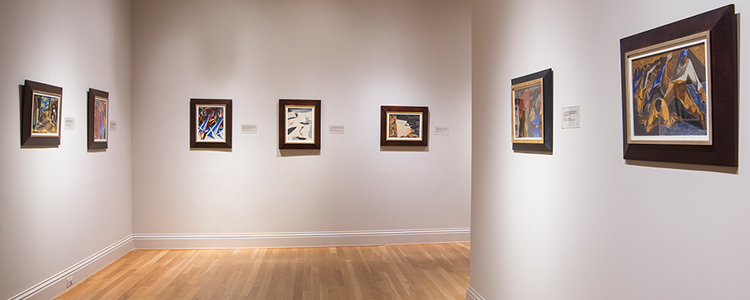This spring, former Phillips curator Beth Turner taught an undergraduate practicum at the University of Virginia focusing on Jacob Lawrence’s Struggle series. In this multi-part blog series, responses from Turner’s students in reference to individual works from the series will be posted each week.

Installation view of Jacob Lawrence: Struggle…From the History of the American People. Photo: Lee Stalsworth
As I reflect upon our semester, I am amazed at how Jacob Lawrence’s Struggle series has opened itself to us for new discoveries about the individual works and about the series as a whole. For a time in this course, we were able to view 30 panels from The Migration Series in a space adjacent to the gallery with the 12 panels from the Struggle series. We began the semester with “mindfully” looking at works from both series. Our observations in the galleries and later examinations of surface and shape taught us a great deal about the viability and flexibility of Lawrence’s practice in tempera paint applied to sequences of same size panels over time. In the nearly 15 years separating Lawrence’s Migration epic and his American History (comprising events from the American Revolution and the Early Republic), we found an amazing continuity in his method: starting with research in the Schomburg Library, next visualization from notes and texts, pencil drawing and notation on the surface (both front and back), and lastly the patterning and improvisational layered application of pure colors. However, unlike The Migration Series, which reads like an epic poem with stanzas and refrains, the Struggle series visualizes the incidents of history by way of individual filmic splices. We feel the quickened pace of being in the moment and psychological intensity in the acute angles of Lawrence’s shapes and in his flashing contrasts of seemingly improvised color. Lawrence’s notations—some of early titles—on the backs of the panels also offered us important clues to the identity of the historical events as well as to his thinking.
For example, on the back of the panel about Patrick Henry’s speech, Lawrence erased the word “Protest.” On the back of the panel about the Boston Tea Party, Lawrence wrote, “Masquerade.” In Lawrence’s work, when a story is being told is as important as what is being told. For him, deep context is important. So our students set about researching historical events and textual sources as well as the current events in 1954–56 when the series was being created. Among them were school integration, the Montgomery bus boycott, and the heinous murder of Emmet Till. The partial or incomplete aspect of the Phillips’s showing of the Struggle series became an opportunity for the students to posit alternate sequences and to underscore key themes such as violence vs. non-violence or the individual vs. society. When given the amazing opportunity to rearrange the Struggle series gallery, we ultimately opted for the 12 panels to be arranged chronologically in the order of historical events. In this way, the reader of the series first finds in the story of the Revolution the image of a Slave Revolt and Petition before encountering Patrick Henry’s appeal for liberty or death which invokes a slave petition. In each of the following parts of this blog series, students respond to different panels and discuss their interpretations and report their research on Lawrence’s work.
Beth Turner, Former Phillips Curator






